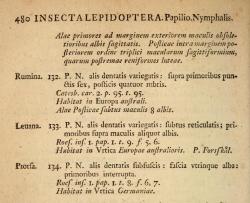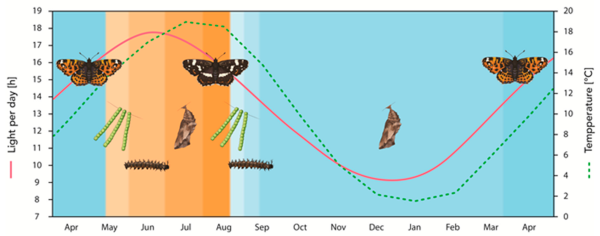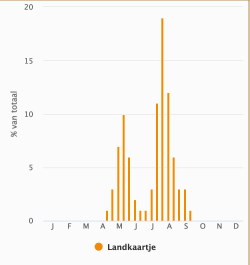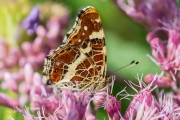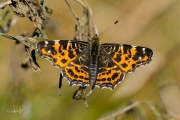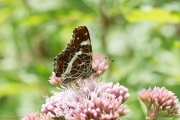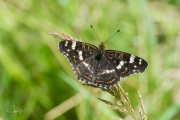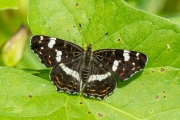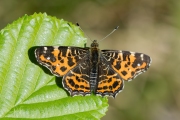The Map (Araschnia levana)
by Theo de la Ruelle
The map butterfly (or the map for short) (Araschnia levana) is a common butterfly in the Netherlands and can be found all over our country. On the other hand, in the annual butterfly count the map does not make the top ten and in most years it doesn’t even make the top twenty. So, what does this butterfly have to do with a map? The explanation for this is simple: just look at the underside of the wings. With a little imagination, the pattern resembles a map. With fields intersected by roads, a wide band like a river and dots that resemble villages and towns. Not only the English thought of a map when naming this butterfly, its name in many other languages refer to a map too. For example, the butterfly is called landkaartje in the Netherlands, Landkärtchen in Germany and carte géographique in France. The Swedes (kartfjäril) and Norwegians (kartvinge) also do this. Although it is a common butterfly at the European continent, the map can’t be found in the United Kingdom. The map was introduced in the UK in 1912, especially in Monmouthshire and Herefordshire. But in 1914 a respected amateur entomologist named Albert Brydges Farn was so opposed to the introduction of a foreign species that he tried to destroy every map he could find. He didn’t manage to exterminate them all, but as a result of other and unknown factors the butterflies didn’t survive. In recent years there have been other records from England, probably genuine migrants although it can also be the result of accidental import or releases of captive-bred species.
Two generations
Like many butterflies, the map has two generations per year. Starting in April you will see the first maps flying. They hatched around August-September the year before as a caterpillar and then went into the winter as a pupa. In early spring they fledge and these first generation maps lay their eggs in April-May. The caterpillar pupates around June-July and fledges some time later as a butterfly: the second generation. They lay their eggs in August-September and the story starts all over again. The stage from egg to pupa for these second generation butterflies lasts only a few weeks. Due to the hibernation period as a pupa of several months, that of the first generation lasts up to eight months. As mentioned, there are more butterflies that have two generations per year, such as the comma butterfly (Polygonia c-album), the large white (Pieris brassicae) and the small tortoiseshell (Aglais urticae). The small white (Pieris rapae) even has three generations and in some good years as many as four. Incidentally, since about twenty years, three generations of the map are also increasingly common.
Two different species?
That a butterfly has several generations is therefore no exception and yet there is something special about the map. The butterflies of the first and second generation are very different in colour. The spring generation is coloured orange with black spots and a few smaller white spots. While the second, the summer generation, has black wings with white bands and fine orange stripes. In the photos below this blog you can see the differences. If you didn’t know any better you would think these are two different butterfly species. Linnaeus also saw two different species in his Systema Naturae (1758) and gave the name Papilio levana to the spring form and Papilio prorsa to the summer generation (see the picture on the left). The German entomologist Jakob Hübner also described the map as two different species in his Verzeichnis bekannter Schmetterlinge in 1816. He however placed them in a separate genus, Araschnia, within the Nymphalidae family. From that moment on, the maps were still considered as two separate species known as Araschnia levana and A. prorsa (see the image on the left). The genus name Araschnia derives from the Greek αράχνη (aráchni), meaning spider and again resembles the pattern on the underside of the wings, in which you can also imagine a spider web.
Dimorphism
At some point it was discovered that they were not two different species of butterflies but one and the same.The way the researcher(s) found this out was quite simple: from eggs deposited by the spring generation gave rise to caterpillars and eventually the butterflies of the summer generation. Therefore it must be one and the same species! This was a surprising discovery, that’s for sure. The phenomenon that there are external differences between animals of the same species is called dimorphism. A very well-known form is sexual dimorphism, for example the differences between males and females in many bird species. Think of the tree sparrow (Passer montanus), the chaffinch (Fringilla coelebs) and the blackbird (Turdus merula), where the differences are clearly visible. In other species the difference is more subtle, such as the kingfisher (Alcedo atthis) where the male has a completely black beak and the female has an orange lower bill. Another good example of sexual dimorphism can be seen in certain moth species such as the winter moth (Operophtera brumata) whose females can’t fly because their wings have evolved into little more than stumps.
Seasonal dimorphism
There is no clear case of sexual dimorphism in maps but of so called seasonal dimorphism. It depends on the season which form emerges. The colour of the adult butterfly is not determined in the egg phase but in the caterpillar stage. After experiments around 1950, it was thought that temperature alone was to blame. A low temperature results in the spring form (sometimes also called A. levana forma levana), a higher ambient temperature results in the summer form (A. levana f. prorsa). Later research showed that there is some truth to this, but that the daylight factor plays an even greater role. If the caterpillar is exposed to daylight for 16 hours or more, the summer form is formed. At 15.5 hours and less, the spring form develops in most cases. Since the butterfly enters the winter as a pupa, the caterpillar gets considerably less daylight in the autumn than the caterpillars that crawl around in April and May. The image below, from a 2018 study by Arne Baudach and Andreas Vilcinskas on seasonal dimorphism, illustrates this. In the pupal stage it is also able to choose if it will hibernate as a pupa or fledge as a butterfly in late summer. This is caused by, among other things, the time of release of a certain hormone (20-hydroxyecdysone) after pupation. Incidentally, studies have also shown that there is not only a difference in colour between the two generations, but also, for example, how the butterfly reacts with antibodies to bacteria, viruses and parasites (immunocompetence).
Third generation and intermediate form
So, with a long and warm late summer, it can also happen that the pupa ‘decides’ to fledge within a few weeks and a third generation of maps will therefore appear. Something that has been happening more and more in recent years due to climate change. In terms of colour, it has something of both the spring and summer form. On the other hand, a cold and gloomy period in June-July can cause those hormones and genes to get a bit confused and an intermediate form is created. This intermediate form also has a combination of the first and second generation in terms of colour. Incidentally, the number of maps in the summer is always higher than for the spring generation. This is because the pupae’s chances of survival are significantly lower in winter than in summer. The two peaks can be clearly seen on the adjacent graph of the Dutch Butterfly Foundation.
Bronnen:
- Dutch Butterfly Foundation
- Butterfly Conservation
- MDPI
- Göttinger Digitalisierungszentrum
- Biodiversity Heritage Library
This blog was originally published in Dutch on August 10th 2021.
